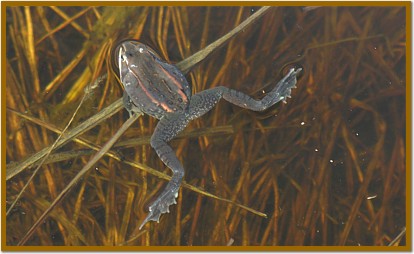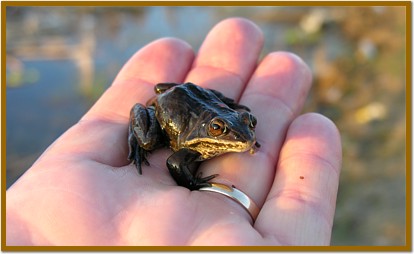
Wood Frogs! |
By Doug Collicutt |

A male Wood Frog in a pond.
Among the many things that herald spring in Manitoba, one of my favourites is the "quork, quork, quork" of Wood Frog males calling for mates.
When winter's snow is all but gone, leaving ponds and ditches brimming with melt water, Wood Frogs emerge from hibernation and get right to the business of breeding.
Wood Frogs (Lithobates sylvaticus) are among the first amphibians to breed each year in Manitoba, starting as early as mid-April in the southern part of the province. (In the very early spring of 2012 Wood Frog eggs were found on March 25! See the Manitoba Herps Atlas for more early spring records.) They are found throughout the province, so they are a spring harbinger we can all appreciate.
Boreal Chorus Frogs, Tiger Salamanders, and the Blue-Spotted Salamander, also breed right after the snow melts. |

The size of a Wood Frog.
Remarkable Critters
Wood Frogs are truly remarkable little creatures. They are the most widely distributed amphibian in North America, even reaching beyond the Arctic circle! They can mature from egg to transformed frog in as little as 45 days (now that's MORPHIN'!). But perhaps their greatest feat is the unique way in which they spend winter, frozen solid!
Wood Frogs are members of a rather exclusive club of vertebrate (back-boned) animals that overwinter on dry land and survive the freezing of their body tissues. World-wide there are only a few species of vertebrates that can tolerate freezing. (Baby Painted Turtles are the "highest" vertebrates known that can tolerate tissue freezing - yet another story to be told!) Though this feat is "no big deal" to many plants and invertebrates (lots of insects do it), it is a neat trick that enables Wood Frogs to inhabit many northern environments and frees them from dependence on permanent bodies of water.
For More on Wood Frogs
Want a little more information on Wood Frogs? Would you like to experience raising Wood Frogs yourself, maybe even in your classroom? Then read on!
Carry on for the Biology of the Wood Frog!![]()
If you want to help conserve amphibians in Manitoba then get involved with the Manitoba Herps Atlas! When you find a critter enter a record to help build a province-wide database of species' locations and natural history. |
